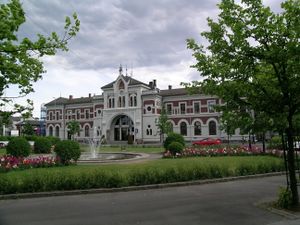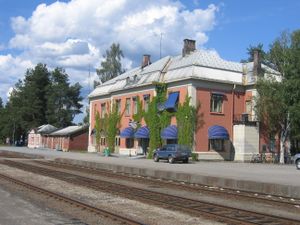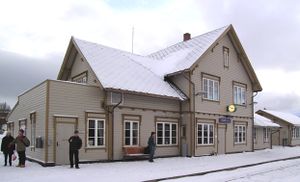Rørosbanen
| Rørosbanen | |
| 250px | |
|---|---|
| Røros Station at Røros | |
| Info | |
| Type | Railway |
| System | Norwegian railway |
| Start station | Hamar |
| End station | Støren |
| No. of stations | 28 |
| Operation | |
| Opened | 13 October 1877 |
| Owner | Jernbaneverket |
| Operator(s) | Norges Statsbaner |
| Character | Regional passenger |
| Rolling stock | BM92, BM93 |
| Technical | |
| Line length | 383 kilometres (238 mi) |
| No. of tracks | 1 |
| Gauge | 1,435 mm (4 ft 8½ in) |
| Electrified | No |
| Highest elevation | 670 metres (2,198 ft) |
Rørosbanen or Røros Line is a 431 km long railway line in Norway running between the towns of Hamar and Trondheim via Elverum and Røros. It connects at Hamar into the Hovedbane (Main Line) to Oslo while the northernmost part from Støren to Trondheim is offically part of the Dovrebane.
Contents
Route
The Rørosbane follows the Østerdal valley, running alongside the River Glomma for much of the way. In terms of the Norwegian railway system the Rørosbane is a secondary route between Oslo and Trondheim, the primary route between those two places being by way of the Dovrebane.
As well as being connected to the Dovrebane, the line also has connections to the Meråkerbane (at Trondheim) and Solørbane (at Elverum). The summit of the line, at Harborg, is 670 metres above sea level – a fairly low elevation for a Norwegian main line. The Rørosbane is Norway's second longest stretch of unelectrified railway, the longest being the Nordlandsbane.
Today, passenger trains on the Rørosbane are operated exclusively by small diesel multiple units of the types BM92 and BM93 operated by Norges Statsbaner
History
The Rørosbane was built between 1862 and 1877, the official opening taking place on 13 October 1877. The route is Norway's oldest mainline railway, defined as one connecting two regions of the country: in this instance eastern and central Norway. Originally constructed as a narrow-gauge railway with a gauge of 1067 mm, the line was upgraded to the European standard gauge of 1435 mm between 1917 and 1941.
Åsta Accident
The Åsta accident occured on January 4 2000, a northbound BM92 multiple unit and a southbound passenger train headed by a Di 3 locomotive collided on the line near Åsta station, killing 19 people. The accident caused a temporary closure of the route while the line's safety was investigated. The Rørosbane being a non-electrified line, the method of cutting the power to trains seen to be on a collision course was not available. Furthermore, the line was not equipped with Automatic Train Control. When the train traffic controller became aware that the trains involved were heading for a collision he tried to send a warning to the train drivers by mobile phone, but the phone numbers were either wrong or did not work. There was controversy in the aftermath about whether the driver of the northbound train had ignored or overlooked a red danger signal or whether the signal system itself was faulty. [1]
Future devopments
The Rørosbane competes for traffic with a main road through the Østerdal and some people have called for the permanent closure of the line to save money, arguing that trucks and buses can handle the extra traffic if the line is closed. Other people have opposed such a closure. [2]
Stations

- Hamar
- Ilseng
- Løten
- Elverum
- Rudstad
- Rena
- Steinvik
- Opphus
- Evenstad
- Stai
- Koppang
- Atna
- Hanestad
- Bellingmo
- Alvdal
- Auma
- Tynset
- Tolga
- Os
- Røros
- Glåmos
- Reitan
- Ålen
- Haltdalen
- Langlete
- Singsås
- Kotsøy
- Rognes
- Støren
- Hovin
- Lundamo
- Ler
- Kvål
- Melhus
- Heimdal
- Selsbakk
- Marienborg
- Skansen
- Trondheim S
References
- ↑ Risks Digest Vol 21
- ↑ Østlendingen (2005-11-23). Rørosbanen vital for us (Norwgian).
External links
| Wikimedia Commons has media related to: Rørosbanen |
- Station list at Jernbaneverket (Norwegian)



